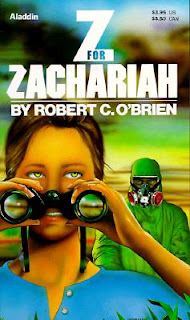Monday Musings: Long Hauls and Minor Characters
If there's one thing I love in fiction—whether it's printed or presented in some audiovisual form like movies or video games—it's a long-haul revelation. I mean something that adds more dimension to a character than it ought to at face value because it fits into what we already know about them and builds on that knowledge in a way that is both satisfying and piquing. One example of this is the revelation about Snape near the end of Deathly Hallows; knowing his history adds a great deal of depth to his interactions with the main characters throughout the series (and fits in with some details we might have forgotten from early on, such as his determination to save Harry in Year 1 when Harry's broomstick is bewitched during a Quidditch match).
But I'm not here to talk about Snape. The title of the post is, after all, "Long Hauls and Minor Characters"—and I have a particular minor character in mind.
Fasir.
I'm going to assume none of you know who I'm talking about, so here's a little more info: he's the (blind?) wise man who shows up in a handful of episodes of the '90s Aladdin TV show Disney produced.
Why do I want to talk about Fasir? Because this guy has one of the best arcs of a minor character in a TV show when it comes to a long haul revelation.
When we first meet Fasir, he's an unnamed old man in the marketplace of Agrabah who is involved in Jasmine's attempt to prove she can survive on the streets as well as Aladdin. Later, he tells the story of a gigantic cyclops whose brother turned him to stone to stop his monstrosity—revealing at the end of the episode that he was the brother (and also a cyclops, albeit a human-sized one).
He goes on to offer wisdom and prophecy during several other adventures, one of which involves Mirage, the vengeful cat-woman (voiced by Bebe Neuwirth) who was responsible for Aladdin's childhood friend becoming a kidnapping monster of the night (but he gets better).
In the episode which cinches Fasir's long-haul revelation, Mirage finds the perfect revenge to take on Aladdin for foiling her previous plans: she tricks Jasmine into using a cursed lotion which transforms her into a snake-person. Jasmine's new body even has poisonous barbs, so that she can't even be with Aladdin without killing him. When they finally reach the tree whose fruit will cure Jasmine, Mirage kills the tree. Rather than be separated from Jasmine (or be forced to kill her; Mirage doesn't care how they're sundered), Aladdin uses the same cursed lotion to become a snake-person. They can live out their lives together, even if they must live separated from human society. This act of true love foils Mirage's plan. Fasir, who cautioned Mirage about the power of love at the episode's beginning, restores the tree, not wishing Aladdin and Jasmine to suffer because of Mirage's hatred.
And then.
Fasir looks on the happy couple, amused by Mirage's outrage and bemusement. She has underestimated the power of love. But Fasir tells himself that Mirage knew love once, and that it will lead her back to him (Fasir) one day.
So this guy has gone from no-name beggar to wise man and prophet to former love interest (and possible redemptive happy ending?) of one of the series' most interesting villains?
Talk about layers.
So tell me: are there any long-haul revelations you love?
But I'm not here to talk about Snape. The title of the post is, after all, "Long Hauls and Minor Characters"—and I have a particular minor character in mind.
Fasir.
I'm going to assume none of you know who I'm talking about, so here's a little more info: he's the (blind?) wise man who shows up in a handful of episodes of the '90s Aladdin TV show Disney produced.
Why do I want to talk about Fasir? Because this guy has one of the best arcs of a minor character in a TV show when it comes to a long haul revelation.
When we first meet Fasir, he's an unnamed old man in the marketplace of Agrabah who is involved in Jasmine's attempt to prove she can survive on the streets as well as Aladdin. Later, he tells the story of a gigantic cyclops whose brother turned him to stone to stop his monstrosity—revealing at the end of the episode that he was the brother (and also a cyclops, albeit a human-sized one).
He goes on to offer wisdom and prophecy during several other adventures, one of which involves Mirage, the vengeful cat-woman (voiced by Bebe Neuwirth) who was responsible for Aladdin's childhood friend becoming a kidnapping monster of the night (but he gets better).
In the episode which cinches Fasir's long-haul revelation, Mirage finds the perfect revenge to take on Aladdin for foiling her previous plans: she tricks Jasmine into using a cursed lotion which transforms her into a snake-person. Jasmine's new body even has poisonous barbs, so that she can't even be with Aladdin without killing him. When they finally reach the tree whose fruit will cure Jasmine, Mirage kills the tree. Rather than be separated from Jasmine (or be forced to kill her; Mirage doesn't care how they're sundered), Aladdin uses the same cursed lotion to become a snake-person. They can live out their lives together, even if they must live separated from human society. This act of true love foils Mirage's plan. Fasir, who cautioned Mirage about the power of love at the episode's beginning, restores the tree, not wishing Aladdin and Jasmine to suffer because of Mirage's hatred.
And then.
Fasir looks on the happy couple, amused by Mirage's outrage and bemusement. She has underestimated the power of love. But Fasir tells himself that Mirage knew love once, and that it will lead her back to him (Fasir) one day.
So this guy has gone from no-name beggar to wise man and prophet to former love interest (and possible redemptive happy ending?) of one of the series' most interesting villains?
Talk about layers.
So tell me: are there any long-haul revelations you love?






Horizon Zero Dawn is a game I love, in part, because of the many mysteries it has and the eventual answers you find. There's one in particular at the VERY end of the story that I love. It requires a lot of knowledge about the game, and perhaps it's not as powerful if you don't experience it, but I want to share it anyways. :P
ReplyDeleteIt goes without saying that this entails some MAJOR spoilers for the game.
This game takes place in a world that has been sent back to the stone age, except for giant, animal-like machines that roam the land. One thing that your character finds throughout the game is these strange, metal flowers that seem to be growing out of the ground, which are surrounded by a perfect triangle of purple, biological flowers. Aloy, the main character, finds out from other characters in the game that these flowers have only been noticed in the last twenty years or so, and no one is quite sure what they are. These are collectibles in the game, so I assumed the triangle of purple flowers was just a way to signal to the players that this was where to find them. (And there's nothing to say that's not the case.)
During the game, you find out that a long time ago, a woman named Elisabet Sobeck had to, for reasons detailed in the game, create an AI named GAIA, whose purpose was to rebuild the Earth after it was devastated for reasons detailed in the game. Sobeck always knew that she'd never live to see the world GAIA had finished, and ended up sacrificing herself to make it happen. GAIA was programmed to be deeply caring about life, as she would have to be a caregiver, and it's implied that she saw Sobeck as her mother.
A long time later, twenty years before the beginning of the game, GAIA realizes she'll have to sacrifice herself in order to protect the Earth she's rebuilt. Just before she is destroyed, she sets a few things in motion - one of which being to start the player character on her heroic journey.
At the end of the game, Aloy finds out where Sobeck was when she died, and decides to go find her. She finds her grave - and surrounding it is a perfect triangle of purple flowers, just like what surrounded all the metal flowers you've found throughout the game. I'll admit, I teared up a bit. I thought it was such a beautiful reveal to a mystery I'd never expected to be answered.